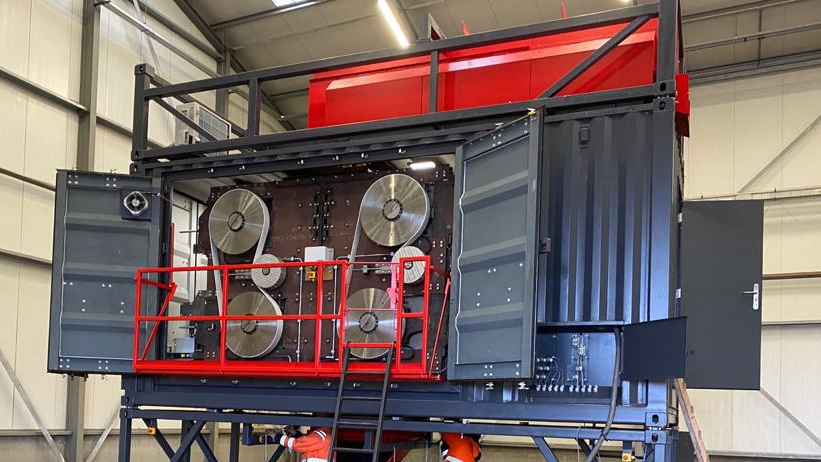End-of-life recovery altering the future of cement with Smartcrusher
Concrete from demolished buildings is mostly used as a fundament for roads. SmartCrusher BV has developed a technology for the processing of used concrete in its heterogeneous composite elements: unhydrated cement, hydrated cement, gravel and sand, which can immediately be used as resources for new concrete on-site. Shifting Paradigms supports SmartCrusher BV with informing policy makers and international financial institutions for the impact that this technology will have on the construction sector.
‘Smartcrusher has been awarded the ASN Bank World Prize in 2014, in the category ‘Renewable energy, nature and environment’
SmartCrusher BV developed a technology for the processing of used concrete from demolished structures. Common practice is to grind obsolete concrete into granulates, which can be applied as a fundament for roads. The SmartCrusher grinds concrete while separating its heterogeneous composite elements. It produces four fractions: unhydrated cement, hydrated cement (both are also referred to as “fines”), gravel and sand (also referred to as “additives”), which can immediately be used as resources for new concrete on-site. This technology can alter the future of the cement and concrete industry.
Economic and technical advantages
The SmartCrusher turns old buildings into a source of valuable materials, often close to the construction sites where they can be used. This has a number of advantages.
Immediate re-use. In concrete, not all cement hydrates. Concrete can contain up to 50% cement which has not reacted. This unhydrated cement can replace virgin cement to produce new concrete on-site. The hydrated cement can be re-used as:
- a mineral admixture,
- an activator for low-carbon clinker substitutes like fly ash and steel mill slag, when heating it to about 450 ⁰C,
- a substitute for limestone in cement kilns, eliminating emission of process CO2 associated with the decarbon-isation of limestone, and cutting the energy demand of the kiln in half.
Significant cost saving. SmartCrusher is negotiating with construction companies for the delivery of the first commercial crushers. Construction companies see the financial merits of:
- not having to dispose of the granulate (in the Netherlands at around 10 EUR/tonne concrete processed),
- recovering the gravel, sand and unhydrated cement from the recycled concrete, saving on both the purchase (estimated at an additional savings of 13 EUR/tonne concrete processed) and transport of virgin materials.
Improved quality. Recycled gravel and sand from a SmartCrusher outperform virgin additives. Research shows that the historic use of these materials in concrete, is an excellent pre-treatment.
Large future potential. The former Dutch Ministry of Housing, Spatial Planning and the Environment estimated the available supply of concrete granulate to increase from 11 million tonne/year to 22 million tonne/year in the period 2003-2020.
Efficient process. One of the by-products of the SmartCrusher is heat. As a result, its products are dry.
High cost-effective climate benefit. CE Delft estimated the potential CO2 emission reduction of SmartCrusher at 1.4 Mtonne/year for the Netherlands. That is excluding avoided emissions from reduced transport of construction materials. With a marginal cost saving of 101 EUR/tCO2, SmartCrusher can save the Dutch economy EUR 141 million per year.
The cement industry is responsible for about 5% of anthropogenic global CO2 emissions. The emissions from the total life-cycle of concrete are an order of magnitude higher. These emissions stem from the fossil fuels, mostly coal, used to heat a cement kiln to around 1400 ⁰C, and from the CO2 which is released from the raw materials used for cement production. Recycled clinker from the Smartcrusher has already released its CO2 and requires heating to only 300 ⁰C to prepare the material for its second application. That explains the large greenhouse gas emission reduction potential of this technology.

Transitional impact
Urban mining with SmartCrusher will significantly reduce the carbon and environmental footprint of the construction sector and contribute to its transition to both a commercially attractive, and circular business model. On government level, it allows countries to meet their climate ambitions without compromising their ability to implement the infrastructure that is needed to build a low-carbon future.
Concrete production is supported by one of the largest extractive industries in the world, second only to water in volumes. Global cement production in 2014 exceeded 5 billion tonne/year. When adding gravel and sand to produce concrete, the volume of materials extracted increases to over 10 billion.
In many countries, the cement and supporting extractive industry continues expanding its capacity, while on the other hand the technical possibilities to recycle concrete and use amortized buildings as a resource rather a liability, are increasing. This can put investments at risk. SmartCrusher therefore calls upon financial institutions to consider investment opportunities in the light of these new technologies reaching scale, and support the low-carbon transition of the construction sector.
For more information: www.slimbreker.nl





